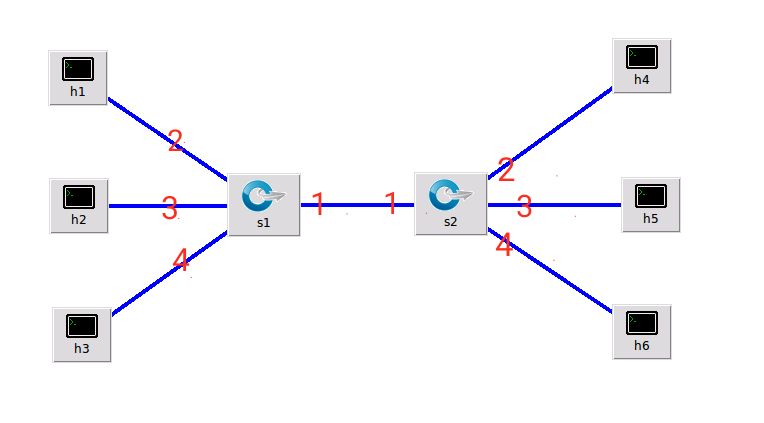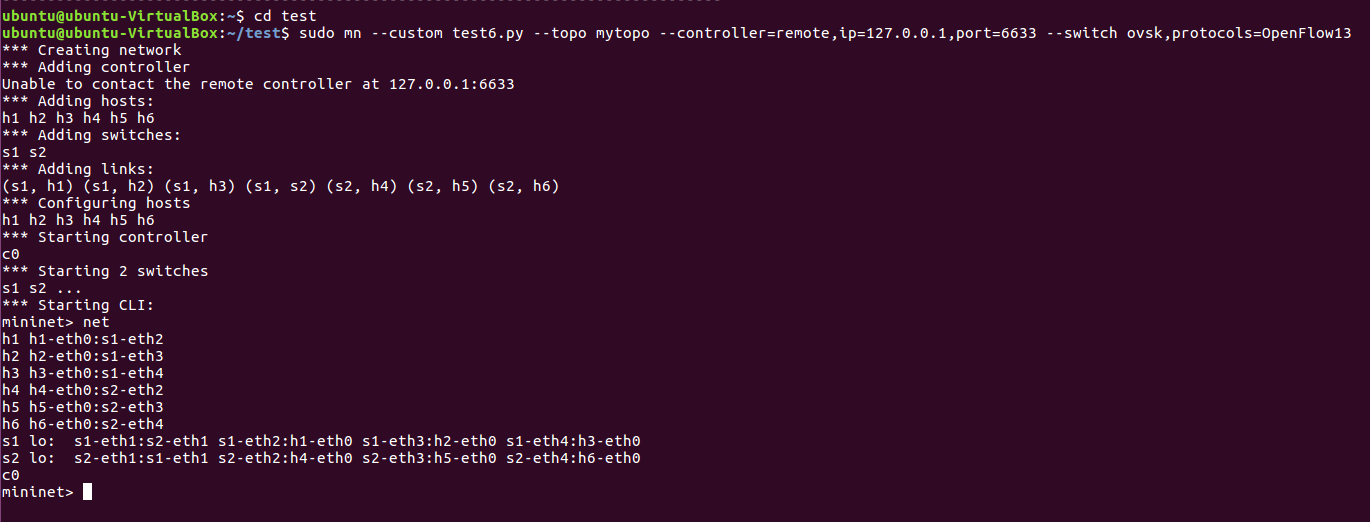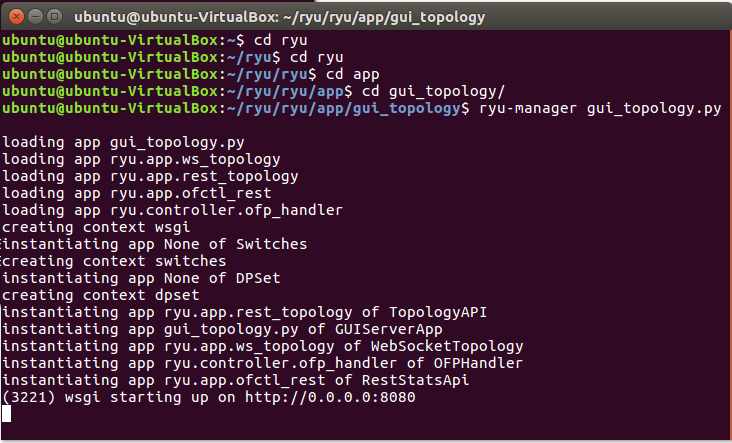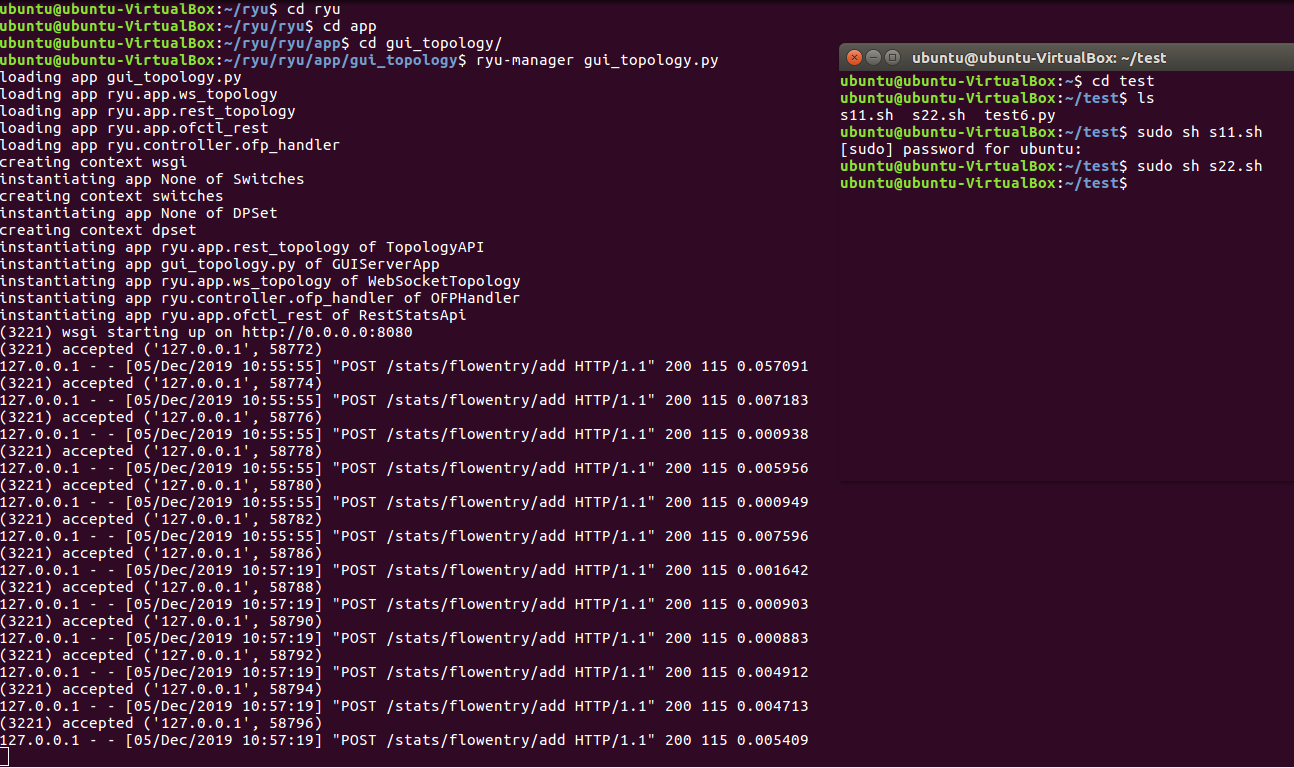1.实验拓扑

python编写网络拓扑
#!/usr/bin/python
#创建网络拓扑
from mininet.topo import Topo
from mininet.net import Mininet
from mininet.node import RemoteController,CPULimitedHost
from mininet.link import TCLink
from mininet.util import dumpNodeConnections
class MyTopo( Topo ):
"Simple topology example."
def __init__( self ):
"Create custom topo."
# Initialize topology
Topo.__init__( self )
L1 = 2
s = []
# add core ovs
for i in range( L1 ):
sw = self.addSwitch( 's{}'.format( i + 1 ) )
s.append( sw )
# link s1 and s2
self.addLink(s[0],s[1])
#add hosts and its links with edge ovs
count = 1
for sw1 in s:
for i in range(3):
host = self.addHost( 'h{}'.format( count ) )
self.addLink( sw1, host )
count += 1
topos = { 'mytopo': ( lambda: MyTopo() ) }
编译拓扑
sudo mn --custom test6.py --topo mytopo --controller=remote,ip=127.0.0.1,port=6633 --switch ovsk,protocols=OpenFlow13

连接ryu控制器

2.使用Ryu的REST API下发流表实现和第2次实验同样的VLAN
s11.sh
#h1->s1
curl -X POST -d '{
"dpid": 1,
"priority":1,
"match":{
"in_port":2
},
"actions":[
{
"type": "PUSH_VLAN", # s1将从主机发来的数据包打上vlan_tag
"ethertype": 33024 # 帧类型0x8100(=33024): 表示IEEE 802.1Q的VLAN数据帧
},
{
"type": "SET_FIELD",
"field": "vlan_vid", # 设置VLAN ID
"value": 4096 # 设置vlan_id的值
},
{
"type": "OUTPUT",
"port": 1
}
]
}' http://127.0.0.1:8080/stats/flowentry/add
#h2->s1
curl -X POST -d '{
"dpid": 1,
"priority":1,
"match":{
"in_port":3
},
"actions":[
{
"type": "PUSH_VLAN", # s1将从主机发来的数据包打上vlan_tag
"ethertype": 33024 # 帧类型0x8100(=33024): 表示IEEE 802.1Q的VLAN数据帧
},
{
"type": "SET_FIELD",
"field": "vlan_vid", # 设置VLAN ID
"value": 4097 # 设置vlan_id的值
},
{
"type": "OUTPUT",
"port": 1
}
]
}' http://127.0.0.1:8080/stats/flowentry/add
#h3->s1
curl -X POST -d '{
"dpid": 1,
"priority":1,
"match":{
"in_port":4
},
"actions":[
{
"type": "PUSH_VLAN", # s1将从主机发来的数据包打上vlan_tag
"ethertype": 33024 # 帧类型0x8100(=33024): 表示IEEE 802.1Q的VLAN数据帧
},
{
"type": "SET_FIELD",
"field": "vlan_vid", # 设置VLAN ID
"value": 4098 # 设置vlan_id的值
},
{
"type": "OUTPUT",
"port": 1
}
]
}' http://127.0.0.1:8080/stats/flowentry/add
#s1->h1
curl -X POST -d '{
"dpid": 1,
"priority":1,
"match":{
"dl_vlan": "0"
},
"actions":[
{
"type": "POP_VLAN", # 给进入交换机的包去除 vlan_tag
},
{
"type": "OUTPUT",
"port": 2
}
]
}' http://localhost:8080/stats/flowentry/add
#s1->h2
curl -X POST -d '{
"dpid": 1,
"priority":1,
"match":{
"dl_vlan": "1"
},
"actions":[
{
"type": "POP_VLAN", # 给进入交换机的包去除 vlan_tag
},
{
"type": "OUTPUT",
"port": 3
}
]
}' http://localhost:8080/stats/flowentry/add
#s1->h3
curl -X POST -d '{
"dpid": 1,
"priority":1,
"match":{
"dl_vlan": "2"
},
"actions":[
{
"type": "POP_VLAN", # 给进入交换机的包去除 vlan_tag
},
{
"type": "OUTPUT",
"port": 4
}
]
}' http://localhost:8080/stats/flowentry/add
s22.sh
#h1->s2
curl -X POST -d '{
"dpid": 2,
"priority":1,
"match":{
"in_port":2
},
"actions":[
{
"type": "PUSH_VLAN", # s2将从主机发来的数据包打上vlan_tag
"ethertype": 33024 # 帧类型0x8100(=33024): 表示IEEE 802.1Q的VLAN数据帧
},
{
"type": "SET_FIELD",
"field": "vlan_vid", # 设置VLAN ID
"value": 4096 # 设置vlan_id的值
},
{
"type": "OUTPUT",
"port": 1
}
]
}' http://127.0.0.1:8080/stats/flowentry/add
#h2->s2
curl -X POST -d '{
"dpid": 2,
"priority":1,
"match":{
"in_port":3
},
"actions":[
{
"type": "PUSH_VLAN", # s2将从主机发来的数据包打上vlan_tag
"ethertype": 33024 # 帧类型0x8100(=33024): 表示IEEE 802.1Q的VLAN数据帧
},
{
"type": "SET_FIELD",
"field": "vlan_vid", # 设置VLAN ID
"value": 4097 # 设置vlan_id的值
},
{
"type": "OUTPUT",
"port": 1
}
]
}' http://127.0.0.1:8080/stats/flowentry/add
#h3->s2
curl -X POST -d '{
"dpid": 2,
"priority":1,
"match":{
"in_port":4
},
"actions":[
{
"type": "PUSH_VLAN", # s2将从主机发来的数据包打上vlan_tag
"ethertype": 33024 # 帧类型0x8100(=33024): 表示IEEE 802.1Q的VLAN数据帧
},
{
"type": "SET_FIELD",
"field": "vlan_vid", # 设置VLAN ID
"value": 4098 # 设置vlan_id的值
},
{
"type": "OUTPUT",
"port": 1
}
]
}' http://127.0.0.1:8080/stats/flowentry/add
#s2->h1
curl -X POST -d '{
"dpid": 2,
"priority":1,
"match":{
"dl_vlan": "0"
},
"actions":[
{
"type": "POP_VLAN", # 给进入交换机的包去除 vlan_tag
},
{
"type": "OUTPUT",
"port": 2
}
]
}' http://localhost:8080/stats/flowentry/add
#s2->h2
curl -X POST -d '{
"dpid": 2,
"priority":1,
"match":{
"dl_vlan": "1"
},
"actions":[
{
"type": "POP_VLAN", # 给进入交换机的包去除 vlan_tag
},
{
"type": "OUTPUT",
"port": 3
}
]
}' http://localhost:8080/stats/flowentry/add
#s2->h3
curl -X POST -d '{
"dpid": 2,
"priority":1,
"match":{
"dl_vlan": "2"
},
"actions":[
{
"type": "POP_VLAN", # 给进入交换机的包去除 vlan_tag
},
{
"type": "OUTPUT",
"port": 4
}
]
}' http://localhost:8080/stats/flowentry/add
使用sh执行s11.sh

使用sh执行s22.sh

查看流表
sudo ovs-ofctl -O OpenFlow13 dump-flows s1
sudo ovs-ofctl -O OpenFlow13 dump-flows s2

3.对比两种方法,写出你的实验体会
- 实验二中的方法是使用命令来下发流表,如果命令中出现一个字符错误需要修改的话,还需要左移光标进行修改,十分麻烦,而在这次实验中,将流表项写在脚本中,只要json的格式没问题,就可以成功下发流表,在后续的修改中也是非常方便的,而且这些脚本也比较容易保存。都是固定格式,只要修改固定项的内容就可以,非常方便。